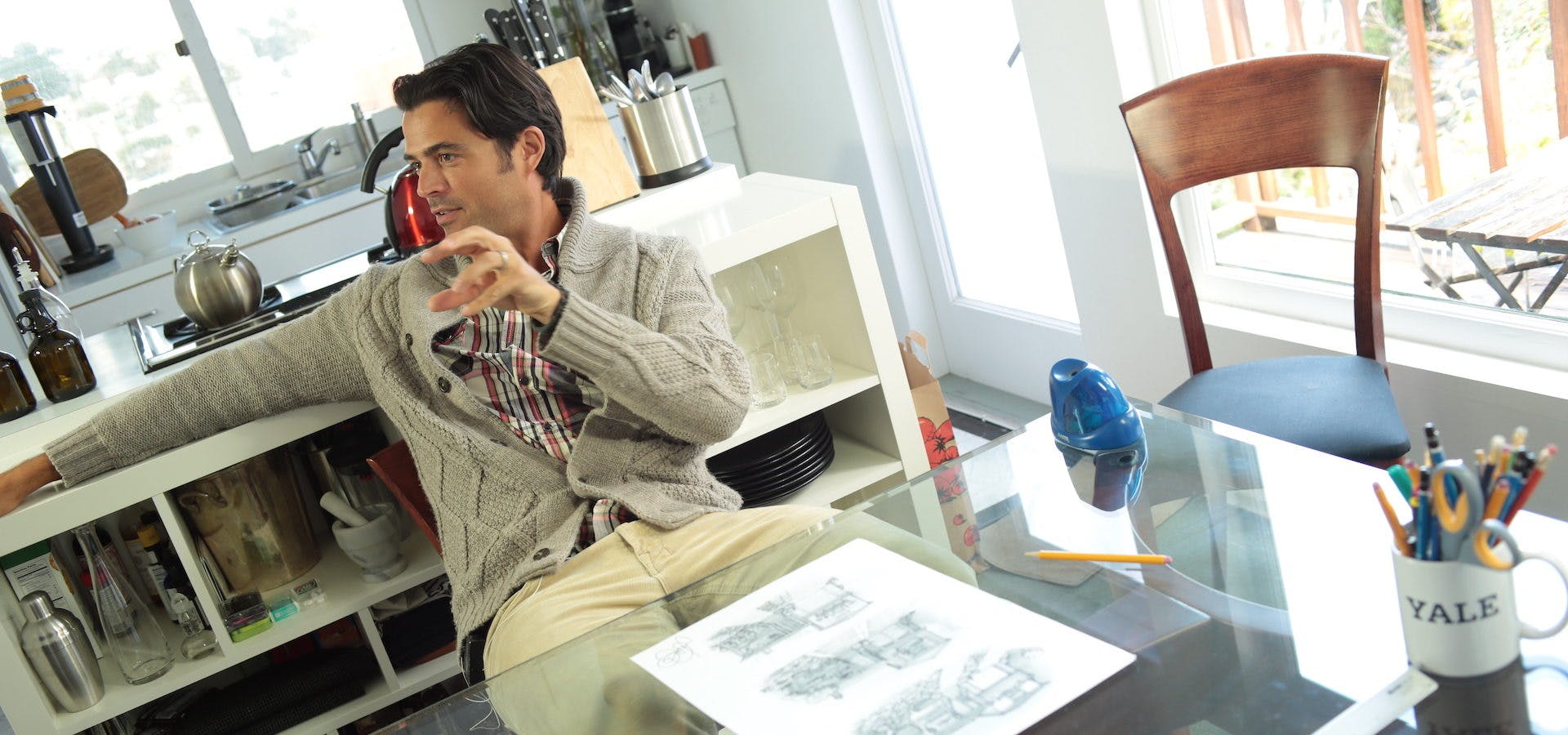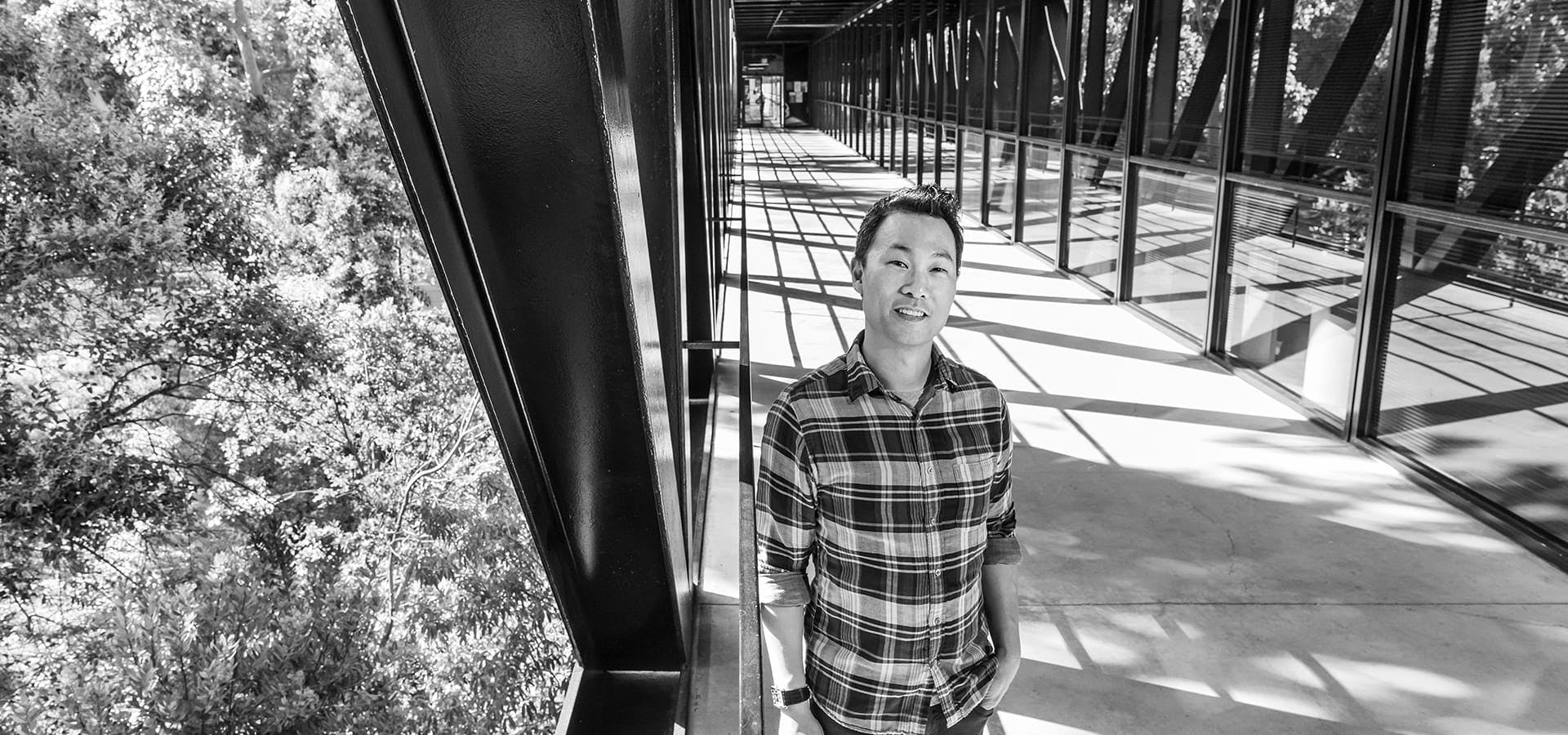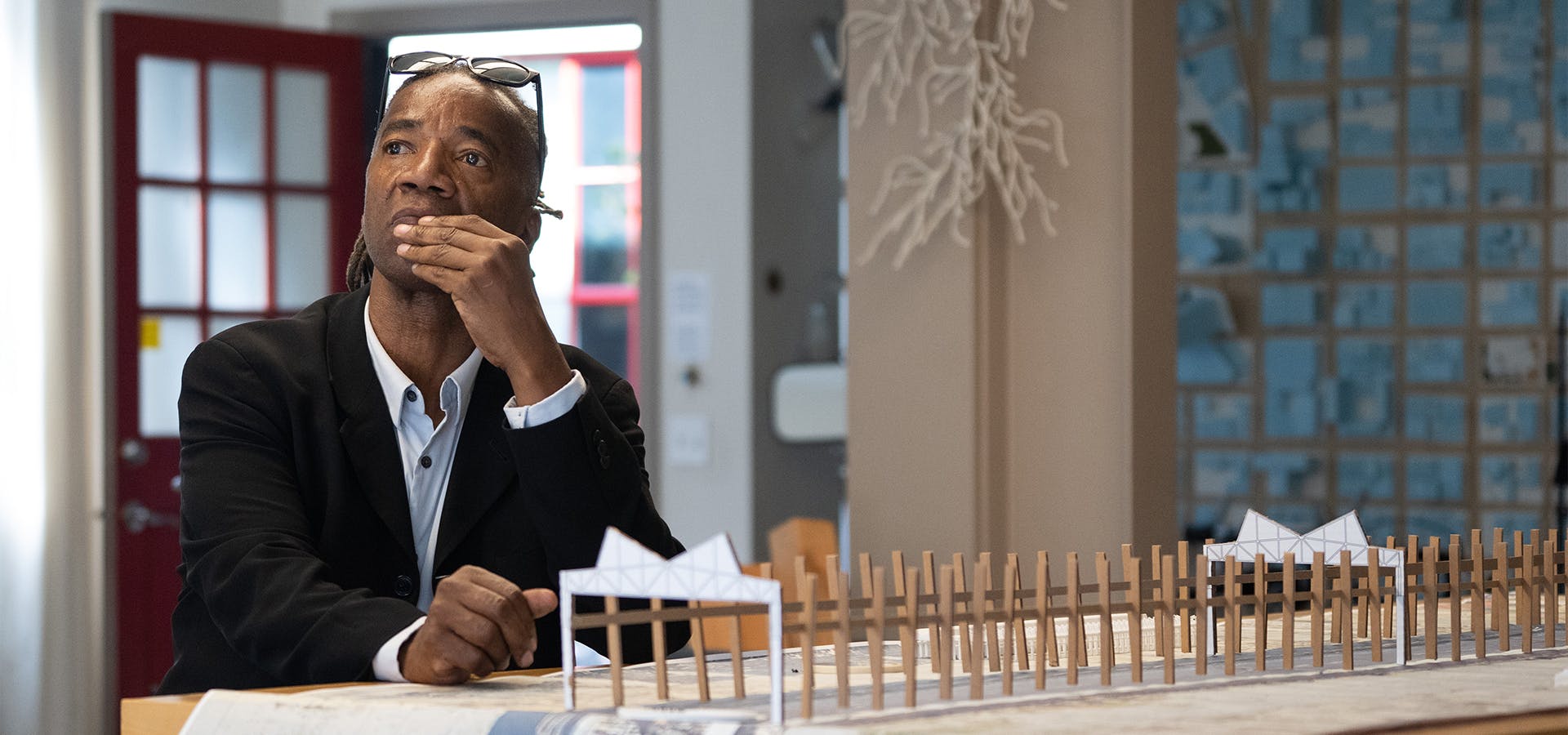All big ideas start with a kernel of a plan. For designer John Gidding, that plan manifests itself as a small sketch. The sketch begets possibility, possibility leads to exploration, and exploration manifests into reality. Despite a global career trajectory that’s placed him everywhere from fashion runways to the sets of various HGTV shows, he always returns to the comfort, warmth and freedom of the sketch.
Born in Istanbul, Turkey, John attended boarding school in Lysin, Switzerland before moving to the US. He received his BA at Yale and attended Harvard Graduate School of Design, where he pursued his Master’s in architecture. His mother still lives in Turkey and his father in Luxembourg, and when John isn’t filming episodes of HGTV’s Curb Appeal Xtreme or his own In The Room with John Gidding for SHLTR—not to mention appearances on shows like Rachel Ray—he’s traveling to make time for family.
If you’ve tuned in to any of the various design shows John has been a part of over the last 15+ years, you know that his expertise is extensive. He prides himself on being a generalist and being inspired by multiple disciplines despite his background in architecture. With the online series In The Room, he’s achieved a level of connection to his craft—and his fans—that he finds truly satisfying. “It’s one to one,” he says of the format. “I’ve had so many private clients over the years, and I know how much they appreciate seeing a design come together for them as we’re chatting. It feels very organic to me.”
We caught up with John in between recording sessions for In The Room to discuss his path from international student to Wilhelmina model to TV host, and explore his love for native landscaping.
Golden State: You were born in Turkey and have lived in Switzerland and New York City, but you’re presently in San Francisco. Would you call San Francisco home?
John Gidding: It’s been home for me a few times. I’ve moved away, I’ve moved back. It really has a draw on me. When I first came out, I moved here because it was the thing to do, and there’s something really special about a city that’s embraced the gay community. Seeing pride flags everywhere actually means a lot when you’re coming from a place like Turkey. It’s an important thing to have your sense of self reinforced and appreciated and enthusiastically welcomed by the city that you live in. And every time I move back I move to a different neighborhood and it’s like a different city each time.

“I very much appreciate and admire people who are specialists, but I’m a generalist. I’ve dipped my toe in every scale of design and I’m going to keep doing that. I think there’s very few spots left for the renaissance man, but it’s great work if you can get it.”
GS: You came out during your graduate school years.
JG: Yes. I was going to architecture school. I’d gone through college and not come out, which was a statement in and of itself! (Laughs) Everyone comes out in college.
GS: And modeling and acting came about very quickly after graduating.
JG: I realized very early on that I didn’t want to be an architect! (Laughs) I could see the kinds of jobs that were available to me. Not only were they low paying but you had to effectively do the same thing over and over again to prove yourself to design a small section of a curtain wall for the first 10 years of your career. At the same time, I had this really strong draw toward design—interior design, furniture design, landscape design—all the designs that I didn’t get my Masters in. I think my main reason for pushing architecture was because I wanted to make my family happy with my decisions. Architecture is such a legitimate way of being an artist/creator. I think if I could redesign everything I would have just gone into arts school. I think that’s why television worked so well for me. Not only was it a smaller scale and more one to one, but the time scales were so quick. In architecture you’re working on a project for decades sometimes. On TV it’s fast, it’s fun it’s energetic…and I never looked back.
GS: And your opportunity on ABC Family’s Knock First, your first television gig, came via a modeling audition?
JG: Yes! My modeling agent sent me into this audition and it turned out to be a TV gig. I walked in with a headshot book, and everyone else was walking in with completed designs. I had my sketchbook on me so I pulled that out. Even to this day the thing I love bringing to the table most is sketching. It’s such a joy. When I was given the opportunity to think about what I wanted to do with SHLTR and In The Room, I immediately said, please let me sketch for you.
GS: Let’s talk about that for a minute. On Curb Appeal Xtreme, your area of focus is limited to exteriors and facades—even though that only represents a small portion of your expertise. When you were concepting In The Room, what was important for you to bring to the table so you could satiate your creativity and ability?
JG: In The Room is exactly how I would build a show around me. It’s one to one. I’m literally trying to put myself in a room that I’ve never been in, looking at photographs and plans. I’ve had so many private clients over the years, and I know how much they appreciate seeing a design come together for them as we’re chatting. It feels very organic to me. I’m so fulfilled with in The Room because space planning has always been my interest. I think that’s why I had such a good time in architecture school because it’s all systems of thinking before you even think about aesthetics; before you think about materials and colors and vibe. I bring the same approach to these episodes of In The Room.
GS: And you have such a limited source of information to draw from.
JG: I get three tight minutes of personality, and I have to glean all the design cues I can from those three minutes. Usually there’s a little glimpse into their life and I get a little sense of their aesthetic, but I really have to do some detective work and make some snap decisions.
GS: While you could easily specialize in multiple design disciplines, but you choose to be more of a generalist. Do you feel that can be a detriment?
JG: This is a world that’s increasingly designed for specialists. You’re supposed to learn one thing and learn it to the nth degree so you can provide the best possible version of that one thing over and over again. I very much appreciate and admire people who are specialists, but I’m a generalist. I’ve dipped my toe in every scale of design and I’m going to keep doing that. I think there’s very few spots left for the renaissance man, but it’s great work if you can get it.
GS: You’re also very passionate about native landscaping. Have you been able to incorporate that into your work?
JG: I’ve not had the chance to do that for Curb Appeal because homeowners, typically in the neighborhoods we work in, aren’t interested in a fully native landscape. They want sod and they want lawns because that’s the look. But I would like a more native landscape to be the norm. I’m writing a book that’s all about native plants, and I’m taking a different approach. Most books on native plantings really come at it from two angles. One, a guilt trip. “Stop installing monocultures everywhere because you’re killing the wildlife” Second, botany. “Here are the Latin names of the 17 native plants that are going to do well in your front yard.” That’s not my approach. I’m taking the approach of, “Here are some interesting stories about plants that do well in certain landscapes around you, here are the old wives’ tales about them, and here are the volumetric studies that I would do if I were designing for you.”
GS: Where did this fascination with native plants come from?
JG: Here we are installing lawn after lawn after lawn, putting weed killers in, and it occurs to me: this is not helping anyone, especially not the wildlife, which ecologists are telling us is in precipitous decline everywhere. Everyone is hurting out there and I think that suburban landscapes are maybe the last lifeline for our natural friends. All their natural landscapes are being decimated. Yes, we want to live in pretty environments, but we also want to leave environments for our kids.
GS: How much of your career and life trajectory to you attribute to your desire to explore places and things?
JG: The best thing you can do for yourself in this world is be exposed, because that exposure leads to growth and improvement. I would say I have been exposed to lots of different environments and ecologies, and having been exposed, I thirst for all of them. I thirst for the urban landscapes as well as the rural ones and the suburban ones, and when I don’t have one I need it. Maybe that’s why I never ended up building roots anywhere. I’m kind of a rolling stone. It’s in my family, actually. I think my great great grandfather was a roaming bandit in the Italian islands. (Laughs) I think it’s a strength, as I try and bring some of it into my work. But it’s also in a way a weakness in that I’ve never built strong roots in any city. I feel like I’m a global citizen in that way.
Gidding Inspired
A few of John’s favorite accounts for design inspo
@kenfulk
@kathykuohome
@shltr
@scadartsales
@young_projects
@joedoucet_
@stephanemanel
@beautifulbizarremagazine
@mesmerized_design
@amplifierart











